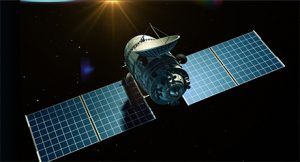A Star Tracker is a sophisticated navigation instrument used in space missions to determine the precise orientation (attitude) of a spacecraft. It operates by capturing images of the stars in its field of view and comparing the observed star positions with an onboard star catalog to compute the spacecraft’s three-dimensional orientation.

How Star Trackers Work:
- Image Capture: The star tracker contains a camera that captures images of the star field in its field of view.
- Image Processing: The onboard processor identifies stars in the captured image and extracts their positions.
- Star Catalog Matching: The extracted star positions are matched against a pre-stored star catalog in the star tracker’s memory.
- Attitude Calculation: Based on the matching results, the star tracker calculates the spacecraft’s orientation in space.
Applications of Star Trackers in Space:
- Attitude Control: Star trackers provide accurate attitude information to the spacecraft’s attitude control system. This is crucial for maintaining the correct orientation of solar panels towards the Sun, antennas towards Earth, and scientific instruments towards their targets.
- Orbit Maintenance: Accurate attitude determination is vital for maintaining and adjusting the spacecraft’s orbit. Star trackers ensure the spacecraft remains on its intended path, especially during complex maneuvers in deep space.
- Scientific Observation: In missions involving astronomical observations or Earth science, star trackers ensure that telescopes and other instruments are precisely pointed at their designated targets. This precision is essential for collecting high-quality data.
- Navigation and Positioning: Star trackers enhance the overall navigation and positioning accuracy of the spacecraft. When combined with other navigation systems like GPS and inertial navigation systems, they provide comprehensive data for precise spacecraft control.
- Mission Operations: For complex mission operations such as docking with the International Space Station, formation flying, or satellite constellations, star trackers help ensure the correct relative positioning and orientation of multiple spacecraft. This coordination is critical for mission success.
Examples of Missions Utilizing Star Trackers:
- Hubble Space Telescope (HST): Uses star trackers to maintain its precise orientation for long-duration astronomical observations.
- Mars Rovers and Orbiters: Star trackers aid in maintaining the correct attitude for navigation and communication with Earth.
- Geostationary Satellites: These satellites rely on star trackers to maintain their fixed position relative to the Earth’s surface for consistent communication and observation capabilities.
- Deep Space Missions: Missions such as the Voyager probes and New Horizons use star trackers for accurate navigation through the vastness of space.
In summary, star trackers are indispensable tools for modern space missions, providing essential data for accurate attitude control, navigation, and precise scientific observations. Their ability to deliver reliable and precise orientation information makes them a cornerstone of successful space operations.
![]()